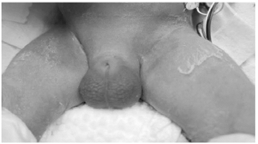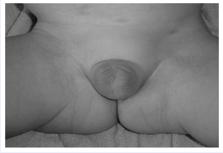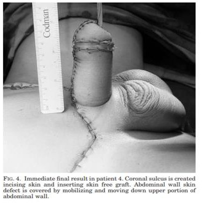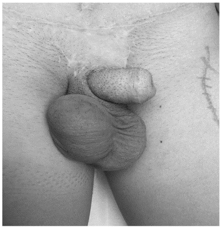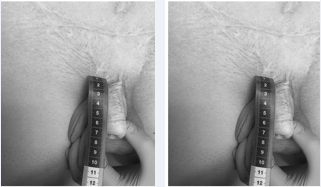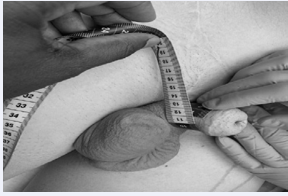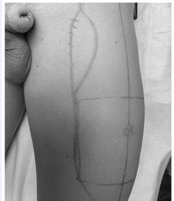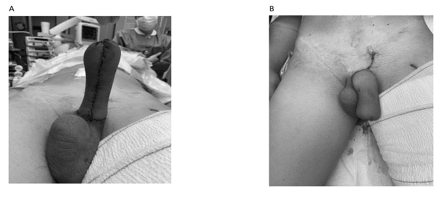Individualized Care for Patients with Intersex (Disorders or Differences of Sex Development): Diagnosis and Treatment of Aphallia and Hypophallia
- 1. Department of Urology, University Hospital, Belgium
- 2. Department of Pediatrics, Penn State College of Medicine, USA
- 3. Department of Pediatrics, Medical College of Wisconsin, USA
- 4. Department of Pediatric Surgery, Hospital CdC Petrucciani, Italy
ABSTRACT
Issues and concerns regarding the diagnosis and treatment of two cases: one initially thought to be aphallia but actually having very severe proximal epispadias with a tiny buried penis (hypophallia) and the second a post-pubertal individual who required further surgery after having surgery as an infant. Subsequent surgery is expected if initial phalloplasty is done before puberty will involve device implantation. Further outcome data is needed to identify the advantages and disadvantages of currently refined techniques. Reviews of the changing techniques reviewed in the discussion document the continuing refinement. The second case discusses an 18-year old young adult born who had penile agenesis with phalloplasty during early childhood who returned and asked for further phalloplasty involving glanuloplasty and implantation of an erectile device. Surgery during infancy or early childhood to create a penis appears to be very important for gender development in a boy especially if there were functional testes during fetal life, even though currently this surgery will be only the first stage. Hence, one cases points out that what may be initially presumed to be aphallia may not be while subsequent surgery is expected if initial phalloplasty before puberty likely even if current techniques are used.
KEYWORDS
Penile agenesis, Penis, male, Phalloplasty, Aphallia.
CITATION
Cinnatti C, Krishna KB, Spinoit AF, Kansra AR, De Castro R, et al. (2022) Individualized Care for Patients with Intersex (Disorders/Differ- ences of Sex Development): Diagnosis and Treatment of Aphallia and Hypophallia. JSM Sexual Med 6(5): 1101.
INTRODUCTION
Penile insufficiency or incomplete penis development in the 46, XY individual can be divided in two groups: aphallia and hypophallia. Aphallia is the most severe form and results in complete absence of a penis. Hypophallia is defined as underdevelopment of the penis leading to an afunctional organ. Aphallia is reported to occur in 1 in 10 to 30 million male births [1]. Categorization is based upon urethral opening in relation to the anal sphincter as postsphincteric, presphincteric or as urethral atresia. The higher the meatus, the greater the incidence of other anomalies and neonatal death [2]. The care of individuals with aphallia is becoming more complex since they are nowadays assigned as male as opposed to the general trend a few decades ago to reassign female. The main shift in approach from female to male assignment with genital reconstruction is largely based on assessment and recommendations of multidisciplinary medico-surgical teams involving geneticists, endocrinologists, psychiatrists, and parents of the child, while previously it was based primarily upon the unattainable goal of a suitable surgical penis construction. Additional factors are outcome data showing poor adjustments after female reassignment plus evidence of normal testicular function from early embryonic life, leading to a masculinization of the fetal brain [3,4]. The impact of normal testicular function includes the influence upon central nervous system development (masculinization of the brain) especially during fetal life and puberty and the expectation of normal hormone secretion and sperm production [4]. The decision to raise such an individual as a male includes the realization that assisted fertility is likely to be required and that surgery to construct a penis is challenging and will require multiple procedures.
This is the fifth article that reviews care of individuals with Disorders/Differences of Sexual Development (DSD) [5-7]. In this article, two specific clinical scenarios are discussed highlighting the need for individualizing the care of each patient. The decision of rearing as male or female continues to be traumatic and problematic sometimes involving inability of parents to agree and make a decision. This manuscript provides a review of the rationale for a male rearing including counselling guidelines for the medical caregivers to provide parents with an approach based upon current data including outcome. Careful counselling is needed to enable parents to move forward in the complex situation of a child being male in all aspects except for the lack of a penis, a situation most parents could not even imagine before. It is clear that surgical outcome will not be ideal, that complications are very likely to occur and that numerous surgical procedures will be necessary, especially if the initial procedure is done during childhood figure 1.
Figure 1 A 46,XY infant born (case # 1) with apparent lack of a penis and descended testes exemplifying assessment, timing and complexity of initial surgery.
|
Example 1: A 46, XY infant born with apparent lack of a penis and descended testes exemplifying assessment, timing and complexity of initial surgery (see Figure 1) This newborn presented with what appeared to be near-total penile agenesis, urethral meatal opening at the location where the penis should be and bilaterally descended testes within a well-formed scrotum. Fluorescence in situ hybridization (FISH) showed normal karyotype with 46, XY and present complete SRY. Ambiguous genitalia sequencing panel with copy-number variants (CNV) showed a heterozygous sequence variant in SPECC1L gene (a new variant of unknown significance). At 6 weeks of age, hormone concentrations indicated normal testicular function and the normal neonatal hormonal pattern at this age. Testosterone was 265 ng/dl, DHT 54 ng/dL, LH 2.0 and FSH 1.6 mIU/ml. At age 3 months, some penile structures that would be entrapped supra-pubic were suspected upon clinical palpation of some poorly developed structures. Exogenous testosterone was administered at 25mg IM every 28 days x 3 doses followed by significant growth of buried structures becoming increasingly distinctly palpable as bilateral hypoplastic corpora cavernosa. At the age of 8 months, phimosis was surgically released by adhesiolysis, revealing penopubic epispadias. The parents agree with male gender assignment while realizing that anticipated long-term issues related to penile structure and urinary incontinence will be challenging at times and distressing and will require repeated surgical procedures. |
|
|
Shared Decision Making |
Surgery |
Two recent cases that illustrate the complexity involved are summarized below:
|
The parents chose a male gender assignment with support from the multidisciplinary team. They were influenced significantly by the presence of functional testes and the assumption that the defect was anatomic, rather than hormonal. It is presumed that androgen secretion during fetal and neonatal life was normal with typical male imprinting of the CNS and that hormonal function and potential for fertility (assisted) will be normal as a male throughout life. Parents were informed of the following: review of embryology of female and male reproductive tract and explanation of anatomical penile structure, including epispadias. Although no other abnormalities are apparent, the parents were informed that mutations of the SPECC1L gene has been found to cause Opitz G/BB syndrome and other abnormalities along the midline of the body, including ocular hypertelorism, brain malformations, and distinct facial features in addition to male genital abnormalities. Aphallia results from partial or complete failure of genital tubercle development, epispadias is generally considered to be an anatomic defect. |
These findings present complex diagnostic and surgical challenges (see Figure 1). Surgery released phimosis and exam under anesthesia revealed entrapped and severely underdeveloped penis with epispadias. Surgical planning for epispadias repair includes reconstruction of urethra, sphincter and penis, pelvic osteotomy and pubic symphysis closure. Although gender identity is rarely in doubt in these cases, outcome data in terms of cosmetic appearance, sexual function and continence are variable in these cases. |
|
Key points: This case involved a multifaceted counseling approach regarding raising a 46, XY male with functional testes without a penis (ranging from an anatomically correct but very small penis to the situations in which it appears that there is no penis). In a previous era raising this child as a male was typically felt to be inappropriate, but subsequent outcome data demonstrated that many developed a male gender identity and clearly indicated that they preferred being male in spite of lack of a typical penis [8]. In this case, it is possible that with hormonal stimulation and current surgical techniques, an improved, more functional penis may result. Though poorly substantiated by limited outcome data publications, there is a possibility of improved penile appearance and size and improved urinary continence at puberty. |
|
DISCUSSION
Until two decades ago, most 46, XY individuals with penile insufficiency were reassigned as female with the plan of creating a vagina and providing estrogen therapy beginning at puberty. Recent literature shows severe gender dysphoria in the majority of these patients raised female and documents a shift toward male reassignment and neo-phalloplasty as the procedure of choice [1,9,10] figure 2.
Figure 2 Patient #2 born with aphallia just prior to initial surgery.
|
Example 2: An 18 year old young man with penile agenesis, early De Castro phalloplasty, documentation of clinical course and subsequent surgery and the current need of glanuloplasty and implantation of erectile device. |
|
|
A boy born with penile agenesis shown in Figure 2 who underwent De Castro phalloplasty technique by the team of De Castro (Figure 3) at 2 years of age [9,10]. He was referred back for further phalloplasty because of dissatisfaction with the result of phalloplasty in infancy with an abdominal flap (Figures 4-6). |
|
|
Gender identity |
Surgery |
|
Although it was felt that phallus was important during childhood enhancing and supporting development of a male gender, lack of phallic growth during puberty resulted in embarrassment and psychological stress during the age of puberty. This resulted in this individual refraining from any sexual self-exploration or other sexual debut. While this boy appeared to develop a male gender identity during childhood, during pubertal years because of lack of genital growth psychosexual development did not progress and self-esteem suffered. |
This boy presented with continent diversion as the urethra in the infant phalloplasty failed so underwent phalloplasty without urethra using the preferred Antero-Lateral Thigh Flap [11]. The result is shown in Figures 6-8. The next step will involve glanuloplasty and implantation of erectile device. From this case it is clear that infant phalloplasty can create a phallus-like structure with sufficient length during childhood but without further growth during puberty because of lack of androgen sensitivity of this tissue. While length is unchanged, penile girth has increased (Figure 5) probably related to the development of abdominal fat (absent within the penis, but present in the flap as this derives from abdominal skin and subcutaneous tissues) within the abdominal flap. Further, in contrast to the penis without hair follicles, hair growth on the abdominal flap results in a hairy phallus. |
|
Key points: Because the population which have had infant phalloplasty is small and its long-term results remain unexplored, it is impossible to draw conclusions regarding the outcome and benefit of such surgery during infancy. Repeat phalloplasty at the age of the onset of puberty after obtaining the patients’ informed consent appears to be mandatory to allow for physical expression of male sexuality. This case suggests that, while phalloplasty during infancy might be important during childhood, further surgery seems necessary with the puberty. As a comparison, a group of 13 exstrophy patients who had phalloplasty during pubertal years were evaluated for psychosexual outcomes, which were reported as favorable [12]. |
|
The two cases presented here include an infant who was initially thought to have aphallia who actually had proximal epispadias and a tiny buried penis. Such patients represent a very severe form of cloacal exstrophy. Thus, aphallia should not be diagnosed until diagnostic investigations are complete including surgical exploration. Because patients with this diagnosis are still able to have sexual function and reach orgasm, parents should not be told that aphallia is present until verified. While the second case is aphallia and there are no images of the initial surgery and it is obvious from the initial photo that that graft was hair-bearing skin unfortunately, there are no images of the case prior to surgery. Also, the figures show an intermediate stage since glanuloplasty is not complete and a penile prothesis has not been placed. Phalloplasty surgery has advanced considerable in the almost two decades since this boy has initial surgery. However, the status of this case should provide a basis for staging of future patients since the literature presented below suggests that staged surgery will continue to be required. While literature is deficient regarding advantages and disadvantages, the goal is to provide information so subsequent stages of phalloplasty,including potential innervation will have better outcomes figure 3.
Figure 3 Results as published in reference 1.
Currently surgery involves vesicostomy in the newborn period is necessary if there is not an urethrorectal fistula. Initial constructive surgery during infancy or early childhood involves, division of the urethrorectal fistula if present, perineal urethrostomy, sometimes with initial, interim phallic creation. Traditional techniques which may be performed before the age of surgery involve temporary construction and phallus formation. These involve groin, abdominal or scrotal flaps. The traditional techniques leave tissues intact that can be used later for microsurgery. Subsequent stages of phalloplasty and urethroplasty are usually delayed until during or after pubertal years and may also involve diversion of urinary outflow from the bladder via the appendix to a stoma (Mitrofanoff channel) into which a catheter is inserted to empty the bladder. The goals of creation of a neophallus is so the individual appears male, can stand to urinate and, with the help of a prothesis, have sexual activity. Such construction may involve traditional and microsurgical techniques [11]. Microsurgical are ‘free flap” techniques involving prosthesis implantation of prostheses. The staged approach is required since the traditional rotational flap technique done at a young age is not expected to grow into which a prosthesis cannot fit [11,12]. The reason that these flap phalloplasties are used preferentially in infants is that construction of a permanent adult- sized neophallus in a paediatric patient is undesirable and this technique spares tissues used for microsurgical free flap phalloplasty for use at a later stage. The original De Castro technique involved an abdominal wall flap using the superficial epigastric arteries as a blood supply is a temporary constructive of a penis [13]. Although this structure has been reported to grow adequately to allow for implantation of a functional prosthesis implantation [12], it generally is considered that later surgery is needed figure 4.
Figure 4 Unsatisfactory results after abdominal flap of case 2 at age 17 years.
Microsurgical procedures are complex with a much longer intra-operative time and may be enhanced by necessitate multidisciplinary team management [11]. They are designed as a single-stage procedure to be performed in adulthood with the concomitant insertion of a penile prosthesis. Microsurgical procedures used in the past include osteocutaneous fibular flap, myocutaneous latissimus dorsi flap and the radial forearm flap [11]. Although many options exist for phalloplasty, the greatest reconstructive challenge in aphallia patients is the urethroplasty. Among these options, the most commonly used is the combined use of groin skin to create the posterior urethra and a buccal mucosal graft to fashion the anterior urethra. However, the majority of patients ultimately require a Mitrofanoff channel to adequately decompress the bladder and protect the upper tracts [11]. It is vitally important to understand which aspect of the reconstructive surgery is most important to the patient and their family to properly manage expectations. Long-term follow-up is essential but there is a distinct lack of information regarding the long- term outcomes of these patients figure 5.
Figure 5 Unsatisfactory phallic length after abdominal flap of case 2 at age 17 years.
An article reviewing the multiple surgical options for both aphallia and epispadias/bladder exstrophy (referred to in this article as hypopahllia) from 2011 [14], identified the goal of an aesthetic and functional phallus. The phallus should allow standing to urinate and ability to penetrate during sexual activity with tactile and erogenous sensation. This article identifies the many surgical options, common complications and need for further surgery, without long-term outcome data. Subsequently, a cursory search of articles published in the last decade describing phalloplasty techniques and outcomes revealed almost 50 articles, although many of these relate to female to males (FtM) transgender individuals figure 6.
Figure 6 Unsatisfactory phallic girth after abdominal flap of case 2 at age 17 years.
The lack of application to born with aphallia or exstrophy- epispadias emphasizes the need for long-term surgical and psychological outcome data. The importance of raising the child male and his having a penis is almost certainly crucial for developing a male gender identity and satisfactory quality of life as an adult [15], completely different than issues for either the FtM or MtF transgender individual [16]. Hence, the systemic review of the latissimus dorsi [17], or forearm [18], free flap phalloplasties among transgender individuals does not appear to provide tactile sensation for those with aphallia, while usefulness for exstrophy- epispadias is unclear Among those with exstrophy-epispadias, concerns relate to long-term function and psychological outcome [19], when transition into sexually active adult life as well as the need for a penis as a child. At this time, the reported concerns regarded penis length that function problems, but without psychological assessment. A literature review of techniques, complications and outcomes of substitution phalloplasty among those with bladder exstrophy-epispadias complex [20], for that among multiple procedures there was a high complication rate but “satisfactory” sexual and psychological outcomes, although this final statement was not validated.
In 2016, there was a review of the techniques and surgical outcomes for individuals with aphallia, penile amputation and FtM transgender [20]. While their appraisal of the then current literature for that there was an overall benefit and efficacy of the various techniques, they found no ideal procedure because of the need for individualization. This need persists with the recognition that there is no evidence that there will ever be a single “best practice” figure 7.
Figure 7 Outline of the ALT flap from the thigh to be used for reconstruction.
Whereas techniques for (neo-) phalloplasty are nowadays well described, results and satisfaction are scarcely reported [10,11,21]. A systematic review from 2016 showed the most common surgical technique during adulthood for aphallia involved microsurgical reconstruction using radial forearm free flap as the most frequent donor site followed (88%) of cases , myocutaneous latissimus dorsi flaps (7%), and osteocutaneous fibular flaps (5%) [15]. Again, this focuses rather on the technique than on its long-term results. These authors suggest that male assignment with subsequent neo-phalloplasty is preferable to a female gender assignment and waiting until gender identity become apparent. Two additional possible procedures used are the De Castro technique and scrotal flap phalloplasty [10,22,23]. A recent modification of this latter technique involved a novel use of acellular dermal matrix (cadaver derived acellular dermal matrix of collagen fibers and basement membrane) used to improve vascularity and wound healing in an infant with aphallia whose parents chose phallic construction [24]. Early (12 month) results suggest a role for tissue engineering and showed a neophallus appearing like an uncircumcised penis [24].
The individuals in this report include 1) a newborn, with associated urological anomalies who voided post-sphincterically who developed sepsis at one week of age and had emergency colostomy and pyelostomy (due to a grossly pyonephrotic single kidney), subsequently had a two stage perineal urethrostomy and scrotal phalloplasty involving a buccal mucosal tube which needed subsequent release due to progressive tethering [25]. At 4 years of age, this boy started school being continent and mingled with peers with “no issues of gender discordance”; 2) a 31 year old 46, XY healthy man from Japan with normal testes without a penis but with an urethral meatus on the anterior rectal wall about 1 cm above the sphincter [26]. He had a history of right nephrectomy because of congenital dysplasia with a left kidney without hydronephrosis and no ureteric dilation. A hypoplastic prostate gland and corpus spongiosum were visualized on MRI. There were no AZF or SRY gene deletions and LH, FSH, testosterone, estradiol and prolactin were all within the normal range. It is noted that he was advised to seek a female without sexual desire for a wife; 3) 3 cases from Iran illustrate the renal and cardiac problems that can be associated with aphallia conditions, including a neonatal death. It illustrates the problem with other anomalies and also the cultural background playing an important role. His parents refusing any intervention; [27,28].
4) Cultural background is also illustrated with this 3 month old 46, XY assigned male from China whose parents did not decide whether to consider phalloplasty. He was lost to follow-up [28].
Currently most of those with aphallia are assigned male at birth and more parents elect to have surgical penis construction. Outcome among those who refuse therapy is not documented. As illustrated above, these procedures have considerable morbidity and require multiple procedures attempting to achieve good functional and cosmetic results [14]. Nevertheless, penis construction is considered vital by parents as part of the multifaceted attempts to avoid or alleviate psychosocial and psychosexual issues during childhood and adolescence figure 8.
Figure 8 A & B: immediate final result of ALT flap phalloplasty, further surgery scheduled.
A recent publication states that the wide variation of strategies and surgeries for masculinizing genitalia has caused a “phalloplasty chaos” [29]. This has led to confusion for health care workers, patients and families. This notes that there is no clear advantage including complications associated with various urethral or phallic procedures, with none shown to be superior. While they state that surgeons need to be knowledgeable of all options, advantages, disadvantages and risks, it also emphasizes the great need for quality of life outcome data.
CONCLUSION
Aphallia and severe hypophallia in 46, XY individuals illustrated by two recent cases illustrate the unknown factors involved in the current variable approaches to this situation. Based on outcome information, they should be assigned male and have surgical penis construction at a young age. The second case, the original case having the DeCastro procedure, is now 18 year of age, and needs redo-phalloplasty with glanuloplasty and implantation of an erectile device. While surgical techniques have been refined, no best approach has been found. Hopefully, this article will encourage other to present long-term functional, sexual and psychological outcomes.
REFERENCES
- Baky Fahmy MA. Rare Congenital Genitourinary Anomalies. Springer.
- Skoog SJ, Belman AB. Aphallia: its classification and management. J Urol. 1989;141: 589-592.
- Reiner WG. Gender identity and sex-of-rearing in children withdisorders of sexual differentiation. J Pediatr Endocrinol Metab. 2005; 18: 549-553.
- Pierik FH, Deddens JA, Burdorf A, de Muinck Keizer-Schrama SMPF, de Jong FH, Weber RFA . The hypothalamus-pituitary-testis axis in boys during the first six months of life: a comparison of cryptorchidism and hypospadias cases with controls. Int J Androl. 2009; 32: 453-461.
- Bangalore Krishna K, Kogan BA, Ernst MM, Lp Romao R, Mohsin F, Serrano-Gonzalez M, et al. Individualized care for patients with intersex (disorders/differences of sex development): Part 3. J Pediatr Urol. 2020; 16: 598-605.
- Lee PA, Fuqua JS, Houk CP, Kogan BA, Mazur T, Caldamone A. Individualized care for patients with intersex (disorders/differences of sex development): part I. J Pediatr Urol. 2020; 16: 230-237.
- Ernst MM, Kogan BA, Lee PA. Gender identity: A psychosocial primer for providing care to patients with a disorder/difference of sex development and their families [individualized care for patients with intersex (Disorders/differences of sex development): Part 2]. J Pediatr Urol. 2020; 16: 606-611.
- Raveenthiran V. Controversies of Sex Re-assignment in Genetic Males with Congenital Inadequacy of the Penis. Indian J Pediatr. 2017; 84: 700-708.
- De Castro R, Rondon A, Barroso U, Ortiz V, Antonio Macedo Jr. Phalloplasty and urethroplasty in a boy with penile agenesis. J Pediatr Urol. 2013; 9: 108.
- De Castro R, Merlini E, Rigamonti W, Antonio Macedo Jr. Phalloplasty and urethroplasty in children with penile agenesis: preliminary report. J Urol. 2007; 177: 1112-1116.
- Oliveira DE, da Cruz ML, Liguori R, Garrone G, Leslie B, Ottoni SL, et al. Neophalloplasty in boys with aphallia: A systematic review. J Pediatr Urol. 2016; 12: 19-24.
- Gouvea JJ, Garrone G, da Cruz ML, Caetano Martins GM, Gomes Parizi JL, Oliveira DE, et al. Penile prosthesis implantation in a patient with congenital aphallia treated using the De Castro technique 10 years previously. Is it feasible? J Pediatr Urol. 2015; 11: 287-288.
- Willihnganz-Lawson KH, Malaeb BS, Shukla AR. De Castro technique used to create neophallus: a case of aphallia. Urology. 2020; 79 : 1149- 1151.
- Bluebond-Langner R, Redett RJ. Phalloplasty in complete aphallia and ambiguous genitalia. Semin Plastic Surg. 2011; 25: 196-205.
- Gupta R, Sharma S, Prabhakar G, Jitendra Prasad Bhatnagar. Why gender reassignment in congenital aphallia. Int J Basic Appl Med Sci. 2014; 4: 160-168.
- Yuan N, Ray EC, Smith S, Garcia MM. Primary use of the deep inferior epigastric pedicle for free-flap phalloplasty: Rationale, Technique & OUtcomes. Plast Reconstr Surg Glob Open. 2022; 10: e4307.
- Kojovic V, Marjanovic M, Radenkovic A, Ilic P, Simic R, Bojovic B. Latissimus dorsi free flap phalloplasty: a systemic review. Intern’l J Impotence Res. 2020
- Kim S, Dennis M, Holland J, Terrell M, Loukas M, Schober J. The anatomy of abdominal flap phalloplasty for transgender surgery. Clin Anat. 2018; 13: 145-151.
- Sinatti C, Schechter MY, Spinoit AF, Hoebeke P. Long-term outcome of urethral and genital reconstruction in hypospadias and exstrophy- epispadias complex. Curr Opin Urol. 2021; 13: 480-485.
- Berrettini A, Sampogna G, Gnech M, Montanari E, Manzoni G, Di Grazia M, et al. Substitution phalloplasty in patients with bladder exstrophy- epispadias complex: A systemic review of techniques, complications and outcomes. J Sex Med. 2021; 18: 400-409.
- Sinatti C, Wolff D, Buncamper M, Verla W, Claes K, Lumen N, et al. Phalloplasty in biological men with penile insufficiency. J Pediatr Urol. 2020; 16: 404-405.
- Morrison SD, Shakir A, Vyas KS, Kirby J, Crane CN, Lee GK . Phalloplasty: A review of techniques and outcomes. Plast Reconstr Surg. 2016: 138: 594-615.
- Bajpai M. Scrotal phalloplasty: A novel surgical technique for aphallia during infancy and childhood by pre-anal anterior coronal approach. J Indian Assoc Pediatr Surg. 2012; 17: 162-164.
- Chaudhry R, Theisen KM, Dangle PP, Schneck FX . Congenital Aphallia: Novel Use of Acellular Dermal Matrix During Scrotal Flap Phalloplasty. Urology. 2017; 105: 167-170.
- Venkatesh SK, Babu PR, Joseph TP, Varma KK . Male Gender Assignment of a Child with Aphallia and Associated Complex Urological Anomaly. JIndian Assoc Pediatr Surg. 2017; 22: 38-39.
- Wang H, Guo K, Wang J, Liu L, Li F. Aphallia in an adult male with 46, XY karyotype. Int J Urol. 2011; 18: 540-542.
- Talebpour Amiri F, Nasiry Zarrin Ghabaee D, Naeimi RA, Seyedi SJ, Mousavi SA. Aphallia: Report of three cases and literature review. Int J Reprod Biomed (Yazd). 2016; 14: 279-284.
- Qiang S, Li FY, Zhou Y, Yuan Y, Li Q. Congenital absence of the penis (aphallia): A rare case report. Medicine (Baltimore). 2019; 98: e15129.
- Lane l, Sluiter EC, Morrison sd, Coon D, Gast KM, Berli JU, et al. Phalloplasty: understanding the choas. Plast Aesthet Res. 2020; 7: 51.
